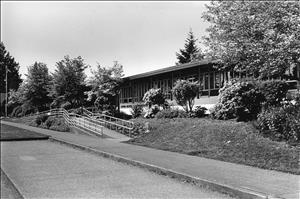This history of Stephen Decatur Elementary School is taken from the second edition of Building for Learning: Seattle Public School Histories, which includes histories of every school building used by the district since its formation around 1862. The original essay was written for the 2002 first edition by Nile Thompson and Carolyn J. Marr, and updated for the 2024 edition by HistoryLink contributor Tom G. Heuser.
Surplus Land
At its peak during World War II, the Sand Point Naval Air Station in Northeast Seattle hosted more than 5,600 Naval personnel, more than 2,400 civilian workers, and hundreds of aircraft. After the Korean War ended in 1953, the number of civilian employees at the base declined to just 200, and the number of residents at Shearwater, a nearby Navy housing complex on 43rd Avenue NE, also declined sharply. However, in the late 1950s, there was still overcrowding at View Ridge and Wedgwood. To solve the problem, the school board acquired the playground area of the Shearwater Housing Project from the federal government, which had declared the area surplus.
Shearwater Elementary School was proposed as the name for the new school. Some parents that did not live in navel housing felt "that the name has no permanent significance as a permanent name for the school." Due to its connection to the Navy, the school was named after Stephen Decatur, an American Naval officer and hero of the Tripoli War and the War of 1812. The name was thought "particularly appropriate" for a Seattle school because the name Decatur had figured prominently in Seattle’s early history. The U.S. Sloop-of-War Decatur provided protection for early inhabitants during an attack by Native Americans in January 1856.
Stephen Decatur Elementary School opened in September 1961 with a K-5 enrollment of 326 from the Shearwater Housing Project and the surrounding neighborhood. Enrollment rose to 367 the following year when the 6th grade was added. Enrollment dropped again to 251 in 1964-1965 with the closing of the housing project. The former housing project office (at 4210 NE 77th Street) was preserved as an annex on the south side of the site. A large parcel of federal surplus property, where the apartment houses had been, was added to the school site in 1966. That same year, although attendance had begun to decline, five classrooms were added to the south end of the main building. They were specifically designed to accommodate team teaching.
Enrollment increased to 477 in 1966-67 with the addition of an accelerated program and special education classes. The accelerated program served north-end students of high academic potential. Four groups of 45 children were transported to Decatur for two half-days each week. A component of the program was a model laboratory where teachers from throughout the state could observe. Although state funding was withdrawn in June 1973, the program continued in 1973-1974 with 52 north-end children in the 5th and 6th grades attending full-time.
In July 1974, Decatur was placed on a district list of schools likely to be closed the following year. Although it was one of the newest schools in the district, it was running well under capacity with an enrollment of 339. The school was not closed, and as part of the district’s desegregation plan, Decatur operated as a K-3 facility from 1978 to 1988 in a triad with Wedgwood and Leschi. In 1979-1980, a modified Montessori classroom for 27 children in grades 1-3 was added. An innovative program called The House System began at Decatur in September 1983, patterned on a similar system in New Zealand. The purpose was to provide "an opportunity for children to mix and work with children from across grades, races, and social groups." Each fall, the entire student body was divided into four "houses," each one signified by a different color. Classrooms were further broken down with 6-8 children in each room being assigned to a different house. The houses came into play during rainy day recess, fundraising drives, and field days.
Closed and Repurposed in 1989
When Decatur finally closed as a regular elementary school in June 1989, it became the home of Alternative Education School #2 (AE #2), which moved there following the closure of University Heights. AE #2 focused on interactive learning and multicultural education. In the first year at Decatur, K-5 pupils took nearly 200 field trips, exemplifying the AE #2 view that “the world is our classroom.” Parents and community members volunteered thousands of hours each year to help the students learn by doing. A salmon conservation project involved students in raising young fish and releasing them into the wild. In accordance with the school’s performing-arts emphasis, teacher Jo Vos led her class in the creation and production of an opera during the 1999-2000 school year.
The school district renamed the school Thornton Creek in 2007, and the following year it was a winner of the “Great School Award.” Enrollment steadily grew thereafter, from 307 in 2006 to 415 in 2015. Enrollment continued to grow at Thornton Creek and in the Northeast cluster of the district, prompting the district to construct a new school for Thornton Creek adjacent to the Decatur building, completed in 2016. The original Decatur building then reopened a year later after minor improvements as the home of the district’s Highly Capable Cohort program for the Northeast region (Grades 1-5). The two schools share design elements to create a cohesive campus.
History
Stephen Decatur Elementary School
Location: 7711 43rd Avenue NE
Building: Brick
Architect: Edward Mahlum
Site: 2.2 acres
1961: Opened in September
1966: Site expanded by 7.71 acres; addition (n.a.)
1989: Closed as regular elementary school in June; opened in September as alternative school site
2007: Alternative school renamed Thornton Creek
2016: Thornton Creek moved to new building
2017: Decatur opened as the Northeast home of the Highly Capable program, grades 1-5
Stephen Decatur Elementary in 2023
Enrollment: 520
Address: 7711 43rd Avenue NE
Nickname: Gators
Configuration: 1-5; Advanced Learning School

